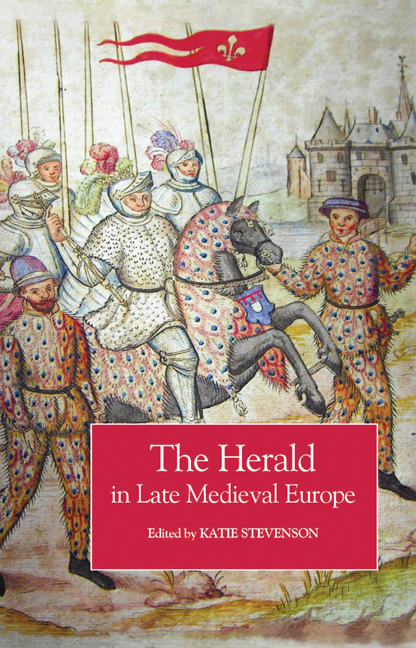Book contents
- Frontmatter
- Contents
- List of Illustrations
- Notes on Contributors
- Acknowledgements
- Abbreviations
- 1 Introduction
- 2 The Development of the Office of Arms in England, c. 1413–1485
- 3 Ancient Precedent or Tudor Fiction? Garter King of Arms and the Pronouncements of Thomas, Duke of Clarence
- 4 Jurisdiction, Authority and Professionalisation: The Officers of Arms of Late Medieval Scotland
- 5 The March of Brittany and its Heralds in the Later Middle Ages
- 6 City Heralds in the Burgundian Low Countries
- 7 King of Arms of the Ruwieren: A Special Function in the German Empire
- 8 Heraldry, Heralds and Politics in the Republic of Florence in the Late Middle Ages
- 9 Tournaments, Heraldry and Heralds in the Kingdom of Poland in the Late Middle Ages
- 10 A time when ‘fools and dwarfs were highly esteemed’? Seeking the Late Medieval Scandinavian Herald
- Index
10 - A time when ‘fools and dwarfs were highly esteemed’? Seeking the Late Medieval Scandinavian Herald
Published online by Cambridge University Press: 26 October 2017
- Frontmatter
- Contents
- List of Illustrations
- Notes on Contributors
- Acknowledgements
- Abbreviations
- 1 Introduction
- 2 The Development of the Office of Arms in England, c. 1413–1485
- 3 Ancient Precedent or Tudor Fiction? Garter King of Arms and the Pronouncements of Thomas, Duke of Clarence
- 4 Jurisdiction, Authority and Professionalisation: The Officers of Arms of Late Medieval Scotland
- 5 The March of Brittany and its Heralds in the Later Middle Ages
- 6 City Heralds in the Burgundian Low Countries
- 7 King of Arms of the Ruwieren: A Special Function in the German Empire
- 8 Heraldry, Heralds and Politics in the Republic of Florence in the Late Middle Ages
- 9 Tournaments, Heraldry and Heralds in the Kingdom of Poland in the Late Middle Ages
- 10 A time when ‘fools and dwarfs were highly esteemed’? Seeking the Late Medieval Scandinavian Herald
- Index
Summary
AT FIRST GLANCE, Scandinavian heralds would appear to be littleknown figures in history. When they are mentioned in source material (rarely, and often unnamed) the focus tends to lie on the various duties associated with their position: participation in tournaments, royal processions, weddings, funerals and coronations, or carrying and presenting royal proclamations and letters. That little is known of the Scandinavian herald's experience is perhaps unsurprising given the historical prejudice long suffered by northern Europe, which has generally been presented as both peripheral and self-centred. For example, M. S. Anderson stated that during the medieval period
northern Europe was still a largely self-contained political sphere. The Scandinavian world was an inward-looking one, linked politically to the rest of Europe only by the tendency of Denmark and Poland to cooperate against the threatening power of the Hanse cities and by the desire of the Danes to protect their trade against the Dutch and the English.
Although this is an extremely narrow description of the situation, it does highlight that Denmark stood out above the other two Scandinavian king- doms in this period. This dominant Danish position is largely reconfirmed in the current understanding of Scandinavian heralds of the later-medieval period, especially as presented by the late Ernst Verwohlt: the vast majority of heralds hitherto uncovered have been almost exclusively connected to the Danish royal court. It is commonly held that Scandinavian heralds only gained regular employment in Denmark after the 1460s, and that there simply were no Swedish heralds until after the establishment of the house of Vasa in 1523. However, this essay considers the medieval Scandinavian herald in a wider European perspective and finds that they were active from at least the end of the fourteenth century. Although to date there has been little research undertaken on Scandinavian heralds, the consistent deployment of both the person and the image of the herald appears to be a normal part of Scandinavian court culture, implying that the role and function of the herald's position was both familiar to and understood by contemporaries. Indeed, heralds were far more than simply ceremonial decoration, but were embodied symbols of royal power.
- Type
- Chapter
- Information
- The Herald in Late Medieval Europe , pp. 169 - 202Publisher: Boydell & BrewerPrint publication year: 2009

